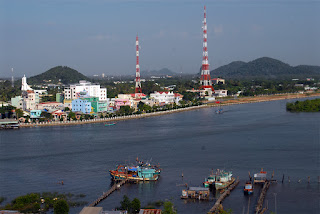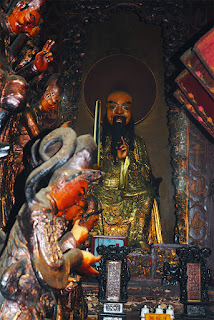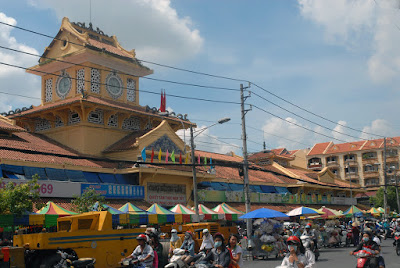by Jim Goodman
 |
| modern Chinese temple in Chợ Lợn, Hô Chi Minh City |
With the collapse of the Ming Dynasty in
1644, many Chinese who were not confident about their future under their new
Manchu overlords, opted to leave China altogether for overseas relocation. A popular choice was Faifo, today’s Hội An, a
thriving port in Central Vietnam that already had a resident Chinese community
since the mid-15th century. In
1567 the Ming Court legalized overseas trade to the south, though not to Japan,
and more Chinese arrived to set up trade, joining the Japanese and Vietnamese
already there.
 |
| street in old Hội An |
At that time Vietnam was divided. Though the Lê Emperor was the figurehead
ruler of the nation, two families, both from Thanh Hoá province, formed
competing governments. The Trịnh Lords
ruled the north down to what is now Quảng Bình, while the Nguyễn Lords governed
the lands south all the way to Nha Trang.
Hostilities between the two sides broke out periodically for two
generations. Four Trịnh invasions failed
and one Nguyễn counter-invasion also failed.
In 1672 the two sides signed a truce and established a boundary between
them that remained intact for over a century.
 |
| Chinese assembly hall in Hội An |
Faifo was the Nguyễn regime’s first and
most important port. During the trading
season the city hosted great fairs featuring both luxury goods like silk,
aromatic woods and jewelry and local products like sugar, pepper, rattan,
cinnamon, musk, eaglewood, lac and gold.
Taxes collected on Faifo’s commerce, while deliberately moderate,
nevertheless were the single biggest source of state revenue.
Meanwhile, back in China, though the
Manchus had declared a new dynasty, they did not yet directly control all of
the country. In the south they made
agreements with ex-Ming generals to rule on behalf of Beijing with a large
degree of local autonomy, even the right to collect taxes of their own and keep
their armed units. Eventually the local
governors decided they could ignore the Qing Court entirely and revolted in the
1670s. Under the young, untested new
sovereign the Kang Xi Emperor, Qing forces subdued all the revolts and
extinguished the last Ming restoration attempt.
 |
| Chinese temple courtyard, Hội An |
In the waning years of the revolt a
group of 3000 armed Ming soldiers arrived in the Nguyển Lords’ realm seeking
asylum. For security reasons the Nguyễn
Court did not want them settled anywhere near the capital. And to refuse them asylum was to invite
trouble. So the Court split them into
two groups and dispatched them to Biên Hoà and Mỹ Tho in the Mekong Delta. It didn’t actually have any authority to do
this, for the Nguyễn state’s borders then were only as far south as today’s
Khánh Hòa province.
 |
| Hà Tiên harbor |
Nominally, the Delta was part of Cambodia, but it was largely swamp back then, with most Khmer settlements near the mouth of the Mekong, too far for direct government control and so autonomous from the beginning. Moreover, instability at the Cambodian Court was the norm, as royal factions fought each other for power. Too weak to prevail on their own they sought allies from Siam or Vietnam. In 1679 a pro-Vietnamese king ruled in Udong, Cambodia’s capital, so getting permission to settle the Chinese in Biên Hoà and Mỹ Tho was no problem.
Now that the truce with the Trịnh regime
was in effect, the Nguyễn Lords began turning their ambitions to the
south. Vietnamese had just started
clearing land in Đông Nai and the Nguyễn Court hoped the admission of Chinese
settlers would enhance river commerce and provide stability for further
Vietnamese immigration. In Biên Hoà this
worked out according to expectations, but in Myỹ Tho Yang Yandi set up a pirate
regime that preyed on all commerce. He
was later killed by his subordinate Huang Jin, who built a fort at Mỹ Tho and
continued to harass river traffic.
 |
| Chinese temple in Hà Tiên |
 |
| imported deity--the Jade Emperor, Hô Chí Minh City |
In 1686 the Nguyễn Court dispatched 6000
soldiers to defeat Huang Jin’s forces and took control of the fort, which
became their base for eliminating the piracy threat. In 1698 they demolished it. That year the regime also took formal control
of Biên Hoà and Prey Nokor, to be renamed Saigon, while more Vietnamese and
Chinese immigrants arrived. Many of the
Minh Hương took Vietnamese wives and learned to speak Vietnamese, while
retaining their Chinese identity and customs.
 |
| Tuê Thánh Chinese temple, Hô Chí Minh City |
 |
| temple interior, Chợ Lợn |
The third group
of Chinese immigrants, called the Thanh Nhân, came during the 18th
century, from different parts of south and central China. They maintained the hair braids and clothing
style of Qing China, did not intermarry with Vietnamese, nor learn their
language. They organized themselves in
associations called bang, based on regional affiliations, and raised
military units to keep the peace. Saigon
drew a great number of them and they were responsible for the city’s commercial
growth.
Among the three
groups, the Minh Hương came closest to assimilation. Some of them rose to become ministers and
advisors in the Nguyễn Lords’ government.
Mạc Cưu’s faction from Guangdong became an early and faithful ally of
the Nguyễn Court. While the Thanh Nhân
group stayed aloof from Vietnamese society, they were reliable Nguyễn
allies. Their armed units even put down
an uprising led by a renegade messianic Lao prince near Mỹ Tho in 1731. The Chinese had less interaction with the
indigenous Khmer, but in general got along with them.
 |
| herbal medicine ship, Chợ Lợn |
 |
| residential neighborhood, Chợ Lợn |
The Mekong Delta continued to lure immigrants in the 18th century. Chinese set up shops in other towns, like Sóc Trăng, Trà Vinh and Cần Thơ, while Vietnamese continued to migrate from Central Vietnam to drain swamps, build canals and clear new farmland. They did not attempt to displace the Khmer, just moved into vacant land in their vicinity. The Khmer were still the largest community in the Delta, but they had always been autonomous, self-contained communities. Even when the Nguyễn took administrative control of the Khmer areas the Court left them pretty much as they were.
The same could be said for the Vietnamese and
Chinese communities. The Delta, still
largely wild land, was a patchwork of little autonomous areas, with their own
military units that sometimes cooperated with the Nguyễn Lords’ regime,
sometimes ignored it entirely. Even the regime’s own military units often
acted according to their own interests.
 |
| local commerce on the Saigon Rive |
By allying with Cambodian royal factions in the endless succession quarrels, the Nguyễn regime could extract greater territorial concessions whenever their side won the contest. But it never established the direct authority in the Delta that it enjoyed in central Vietnam. Subject to its own palace intrigues, the Nguyễn system began collapsing in mid-century. In 1771 the Tây Sơn Revolt commenced, named after the village in Bình Định province that was home to the three brothers who commanded it—Nguyen Nhạc, Nguyen Huệ and Nguyen Lữ.
The Tây Sơn
forces steadily advanced north, but halted short of Phu Xuân, the Nguyễn Lords’
capital near modern Huế. Meanwhile, the
Trịnh Lords broke the truce and in 1774 captured Phu Xuân. The Nguyễn family fled to the Mekong Delta. But the Trịnh forces retreated north later
and the Tây Son took over the city. In
1777 they sent an army into the Delta, shattered the Nguyễn defenses, captured
and publicly executed every member of the Nguyễn royal family except for 14-year-old
Prince Nguyễn Ánh. After that the
invaders returned to Phu Xuân.
 |
| modern architecture in Hô Chí Minh City |
 |
| skyscrapers dominate Hô Chí Minh City |
For the next 25
years Nguyễn Anh patiently organized his restoration campaign. His family had not really established a
strong base in the Delta and he could only win support by arousing loyalty to
him personally. He did this by cultivating
personal relationships with regional commanders and keeping promises to those
who joined his cause, even surrendered Tây Sơn officers. He had several reverses along the way, barely
escaped with his life at one point, but eventually united the Mekong Delta
people and marched north, took the Tây Sơn capital and established the new
Nguyễn Dynasty in 1802.
To a great
extent the Tây Sơn aided his cause by their extremely harsh rule when they
occupied the Delta. Learning of his
survival, in 1782 Tây Sơn forces invaded the Delta, advanced into Saigon and
slaughtered at least 10,000 Chinese residents.
Their purpose was to crush the Nguyễn economy (Portuguese merchants in
Saigon then were also murdered). They’d
done that before in Hội An and Đà Nẵng, but after this incident Chinese in the
south threw all their support behind Nguyễn Ánh.
 |
| the Chinese-built Clay Pagoda in Sóc Trăng |
Three years
later the Tây Sơn returned to defeat a Siamese naval expedition in support of
Nguyễn Ánh. This time they left a
residual military force to administer the region, so brutally as to alienate
those parts of the population that had previously been unaffected. Regional militias from all three major
communities joined the Nguyễn side and helped expel the Tây Sơn in 1788 and
marched all the way to Hanoi for his final victory.
The new emperor
took the name Gia Long and appointed one of his southern commanders to govern
the Delta. Chinese businesses revived
and grew, though the Delta was still very under-populated and the Vietnamese
not a majority there until well into the 19th century. When the French took Cochinchina, as they
called the Delta provinces, they promoted policies that favored the
Chinese. Along with the British and
Russians, they had already forced on China the First Convention of Peking,
which permitted Chinese to seek overseas employment, especially to their colonies.
The colonial
regime also sponsored the internal migration of northern farmers to unoccupied
lands in Cochinchina to make new farms.
Chinese immigrants came to set up commerce in the new towns, though most
19th century immigrants settled in northern and central
Vietnam. But in the 1920s and 30s,
around 600,000 Chinese fled the civil war and moved to Vietnam, mostly in the
south.
 |
| Chinese temple in Trà Vinh |
 |
| opera performers, Hô Chí Minh City |
They thrived in their new locations, thanks to French favoritism, and continued to dominate business and commerce with the creation of South Vietnam. With the northern conquest in 1975 and the imposition of a state-run economy, the Chinese community suffered enough to lead many of them to try to escape, like the ‘boat people’, especially after the Vietnam-China War in 1979, when all Chinese residents’ loyalty to Vietnam was under suspicion.
That suspicion
disappeared after the 1990 normalization of ties between the two
countries. Vietnam had already launched
its new, semi-capitalist economic renovation program and the Chinese in the
south were quick to take advantage. Hô Chí Minh City, ex-Saigon, became the most prosperous city in Vietnam, with
towering skyscrapers comparable to other Southeast Asian metropolises like Bangkok,
Singapore and Kuala Lumpur..
 |
| Chinese opera performance, New Year in Hô Chí Minh City |
It’s still the
most modern-looking city in the country, even while development has sponsored
similar changes throughout Vietnam’s cities.
Hô Chí Minh City has a few old temples, but no real Old Quarter like
Hanoi, just some remaining European buildings from colonial times. Chợ Lợn, the city’s main Chinese quarter,
(the name means Big Market) has also modernized, but is still a tourist
attraction for its very Chinese atmosphere, food, market, Buddhist temples and
Catholic Church. The Chinese temple to
the Jade Emperor, in another part of the city, still attracts devotees and
visitors.
Vietnam’s
Chinese, officially the Hoa minority, are now fully integrated into Vietnamese
society. While they may retain many
Chinese customs and practices, the exclusivity that used to mark the Thanh Nhân
Chinese has vanished. Vietnamese have
historically been wary of China, often with good reason, but in general accept
the Hoa community as fully Vietnamese.
Relations between the two countries flare up at times, usually over
competing offshore sovereignty claims, but local anger tends to target recently
established Chinese business enterprises and not the home-grown Chinese
community.
The Hoa are the
main engine driving Vietnam’s industrial and commercial growth. The government is not likely to upset their
role, no matter what happens with China.
Vietnam’s Chinese, in turn, are not going to do anything politically to
undermine their enhanced economic condition.
To them, more than ever, Vietnam is a Land of Opportunity.
 |
| Chợ Lợn Market, Hô Chí Minh City |